In the horticultural world the subject of plant pest and disease is often known as P&D which is what I will refer to it as forthwith because I am not a good typist. Over the years my position in the bonsai world has been elevated, partly by some good work, and partly by the opinions of some nice kind folk who like me, or much more likely, like what I do. Thanks to those wonderful folk I have a voice and with it I like to pass on the benefits of my, now extensive experience. I like that I can do this for free too, so please keep buying your bonsai supplies from Kaizen Bonsai and I will keep writing 😉
One of the big problems I have with my slightly elevated position is that I am called on for advice daily. This can be a big problem, spending an hour on the telephone every day is extremely inconvenient especially when I am paying for the call. I need one of those premium rate phone lines then I can retire and just sit in my old armchair chatting all day whilst drinking tea and talking bollocks. However, one thing this does allow me to do is become familiar with the problems folk are having with their bonsai. I don’t do social media and so this is actually one of the upsides of my hours spent on the blower.
Before I get into todays subject I have to just pop up onto my soap box here for a moment and vent a little…… I heard on the news recently that UK doctors are having problems with patients coming in to see them and having self diagnosed via the Internet of Cobblers are ignoring advice and demanding medications with, to sane people, obvious potentially serious consequences. I think I am on safe ground here when I say there is more sh*t on the internet than quality factual information. The nonsense, fake news, dishonest advertising, hyperbole, lies, hatred and insanity are a blight on the human race, by and large. We claim to have ‘evolved’ into something so clever and all knowing but seem entirely incapable of seeing our own stinking stupidity. The future of the human race on earth may well be shorter than the life span of our bonsai trees.
As a person who thrives on new challenges I am always up to something new. I spend a great deal of time on the web, sifting through the BS, learning new things I then go out and practice in order to perfect in the real world. With my, now, half a century of life experience I can apply a certain level of good old fashioned common sense I learned from my father and grandfather in order to filter out the attention seeking gobshites and the snake oil salesmen, with a little work I quickly get to the genuine folk who are good teachers expounding their real world skills learned over decades. Last year I learned how to use a metal working lathe and whilst it is an ongoing project I have, even though I say so myself, knocked up some very nice looking, functioning motorcycle parts and carving tool prototypes. In the past I learned hundreds of things from traditional lime plastering, various forms of welding, making Damascus steel knives to recreating 70 year old motorcycle wiring, fitting and removing big tyres, timing camshafts and sharpening straight razors. In fact I would say my most engaging hobby is learning new things. It is beyond me why so many folk only us the internet for entertainment and upsetting each other on social media (antisocial media?) which I purposely avoid like polonium tea bags. An opinionated old duffer like me is just going to get in trouble.
Please stick with me here, I have not forgotten my thread, it’ll be worthwhile when we get there. So, I think we can say the internet is good for at least three things….
- Upsetting folk we hardly know.
- Baffling ourselves with bullshit.
- Learning valuable new life skills.
- Finding out really helpful information.
I know I said there were three points but once I got there I thought point 4. was important too.
Going back to doctors, or at least the point I was making. If you have a symptom and look it up online chances are, within a few minutes, you will be very close to your last breath. People like to exaggerate and since grammar has begun to loose it’s power everything has been taken “too another level”. The modern tendency to use a sledge hammer to kill a fly means so many things are presented as so much worse than they actually are. Add plagiarism into the mix and the constant re-publishing, amendment and exaggeration of fundamentally flawed content and you have the ‘nutters running the nuthouse’ to quote a very non PC phrase (of which I know many and yes I know mental health issues are not a laughing matter). We end up where a patient sits there telling a doctor his job and sues the doctor when they don’t get there own way. Who DID open up the doors of that nuthouse?
This relates very powerfully to bonsai and IN PARTICULAR to P&D. As an example. A few years ago I sold a very expensive piece of Italian yamadori to a very good customer of ours. The tree did all the right things and with some outside help our guy was bringing this tree on in leaps and bounds. I bumped into him over the winter and he asked me for advice on his tree. He shew me a picture of some pretty fungi (mushrooms) growing around the base of the tree. Leaping to the conclusion that all fungi are the end of all life he panicked. After posting the images online he was advised (this is true!) to burn the tree. Seriously, I have heard some incredible shit in my time but this has to take the prize. Why would you burn a very valuable, beautiful and important bonsai tree because a few ‘shrooms’ appeared out of it’s soil? Who made the leap from mushrooms to such a virulent destroying toxin that fire is the only answer?
As it turns out estimates suggest there is more life buried underneath the surface of the earth than exists upon it’s surface. Kingdom fungi is the largest and most diverse group of organisms on earth with an estimated 2.2 to 3.8 million species of which less than 5% have been identified. A large proportion of those species we have identified have proved problematic to plants, which is why we have spotted them. However by far and away the largest proportion get on with their daily existence unnoticed and of little consequence to anybody.
Fungi are important. Because they do not photosynthesize their energy needs from the sun like plants do they have to gather their energy from other sources. By and large this is from dead organic plant matter. Some also work with plants in a symbiotic relationship, promoting plant growth whilst taking a little for themselves. Fungi, mostly, work tirelessly recycling organic rubbish, extracting energy from it and returning the rest back to the ground for re-use. Without fungi the world would be miles deep in dead vegetation and organic waste and the soil would be incapable of supporting plant life. All life on earth is dependant upon fungi doing their jobs. Sure there are some rogue elements that can cause harm but these are in the minority.
As humans we fear what we do not understand and seek to destroy those things through fear. As kids, fearful parents instil in us a sense of fear to do with any type of mushroom or fungi. Pretty red mushrooms look very appetizing to small kids and it’s probably a good idea to keep the two apart. However later in life that fear stays with us even though, as it turns out, most red mushrooms are Ok to eat. The most dangerous in the UK is probably one of the most beautiful pure white mushrooms, the Destroying Angel (amantia virosa). Don’t eat this! In fact don’t eat anything you find unless you are familiar with what you have but don’t also assume that all fungi are bad, either to eat or for the health of your garden or bonsai trees. By and large fungi, like most P&D only attack plants that are weak, distressed or in some other form of environmentally induced weakness. Much like people, healthy specimens have an inbuilt resistance to P&D.
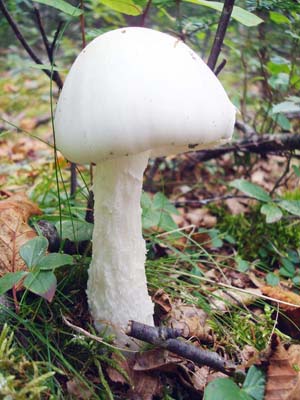
The Destroying Angel. Eat half of this and there is no cure, you will die.
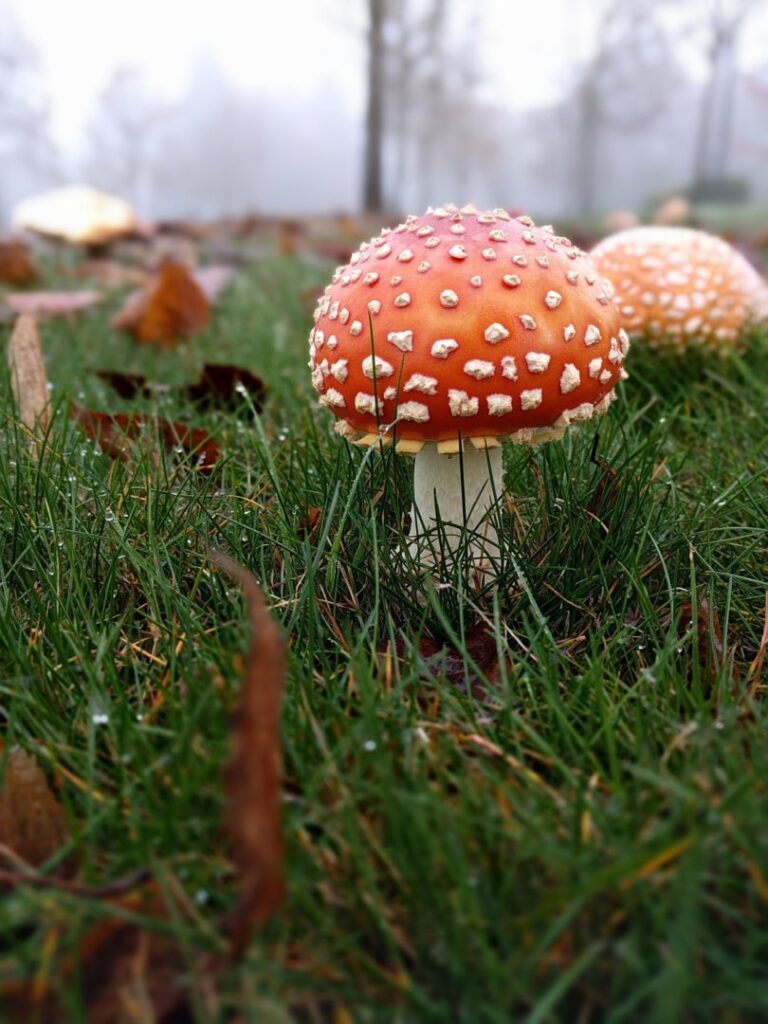
Eat this and you may be high as a kite but you won’t die.
Just because you see some mushrooms around your bonsai tree or other fungal activity, don’t assume it’s bad, it’s more likely to be a positive thing and shows a good balanced and healthy rhizosphere. Part of the trouble with bonsai trees is that, due to the way we keep them in tiny pots they are always under some form of stress. There is too much temperature fluctuation within the root system, too hot in summer and too cold in winter. It’s also hard to regulate the right moisture level in the soil and all but impossible to maintain the perfect nutrient balance. Not only that but our little pots, mostly do not allow sufficient root mass to exist to give us any buffer zone. Bonsai are then all too often messed with via, excess pruning, poor sighting in the garden and too infrequent ill advised re-potting and it’s easy to see bonsai trees spend their lives under considerable stress. Most can withstand this but it’s really easy to see one of our trees dropping on the wrong side of the line. When this happens the plant is a sitting duck just waiting for an infection of some sort.
Another factor to bear in mind is just how many non indigenous varieties we try to grow. Everywhere in the world plant P&D exist and most of them are kept at bay by the local environment or other controlling factors. Take a plant out of it’s natural environment and there is always a chance that natural control will be lost and P&D can become very difficult to control. Many plants are a bit like a fish out of water in a foreign land and the stress of this coupled with a lack of environmental control of P&D can spell trouble.
By far the most important factor in keeping P&D at bay is quality care of trees, ensuring they are hale and hardy and that stress levels are kept to a minimum thanks to quality horticulture and good nursery practice. A sick tree is normally the result of poor horticulture and once on the back foot it often seems all but impossible to recover a trees equilibrium. Of the many sick trees we encounter by far the most significant number are junipers. This beautiful and very common variety is so significantly misunderstood that 90% of the seriously poorly trees we encounter are some form of juniper. I would go so far as to say that probably over 90% of all junipers imported from Japan survive less than ten years at the hands of UK bonsai hobbyists. Most Japanese junipers are not suited to the UK climate with it’s cool mostly dry summers and long wet mild winters.
Over recent years there is a significant problem concerning the health of junipers that, by and large, has gone entirely unnoticed here. Thankfully it’s easily controlled once spotted and just getting on top of this seemingly insignificant fungal problem will significantly help junipers growing in Blightly. In fact this fungi is detrimental to all genus cupressus species.
If you have seen this on your junipers please read on….
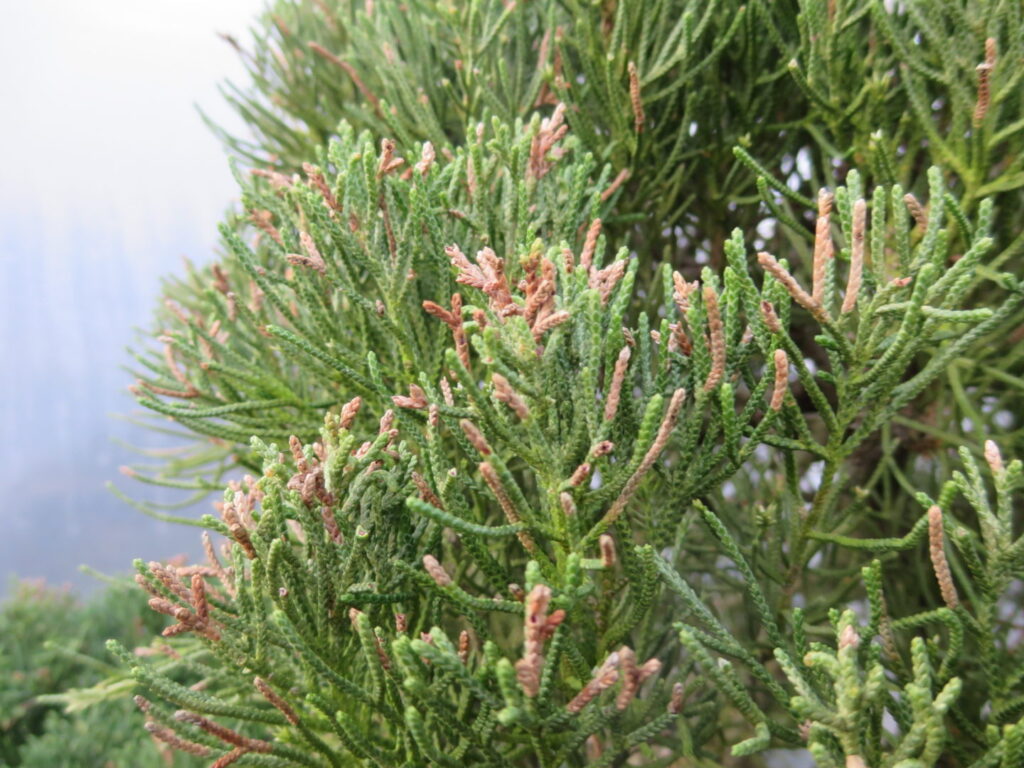
Whilst this may look like a simple case of scorch caused by summer heat or freezing winter winds it is in fact Phomopsis Tip Blight: This disease is caused by the fungus Phomopsis juniperovora and begins by infecting the tips of branches smaller than the diameter of a pencil, in particular new spring growth.
The new, immature growth becomes infected while the darker green, mature foliage remains resistant to infection. Infected twigs first become pale, then turn reddish-brown and finally become brown after death. Scraping away the bark will reveal a sharp line between discolored, dead wood and healthy wood. Watch for disease development during the spring or summer flush of new growth when warm, wet conditions are present.
Phomopsis blight is a common fungal disease and begins infecting young leaves at the tips of shoots. Small yellow spots appear first, and as the infection spreads, the leaves die, with the shoots fading to a light green and then reddish-brown and eventually dying back with an ash-gray color. Only new growth is killed, with dieback occurring in spring. Black fruiting bodies can form three to four weeks after infection.
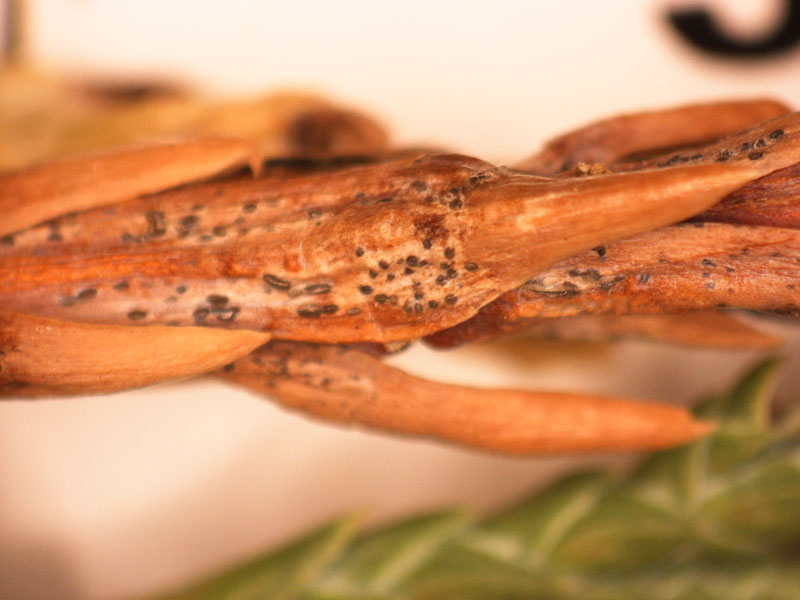
Black fruiting bodies on dead foliage.
Repeated infections occur when temperatures are between 70 to 80 degrees, during periods of high humidity and when foliage is wet. Continuously wet foliage is needed for infection to occur. Areas with heavy shade and poor drainage allow for moist, slow-drying conditions ideal for the disease to thrive. Left untreated we have seen junipers die from this infection as the tree is progressively weakened over a few years. Thankfully we have found treatment to be very easy and also very effective.
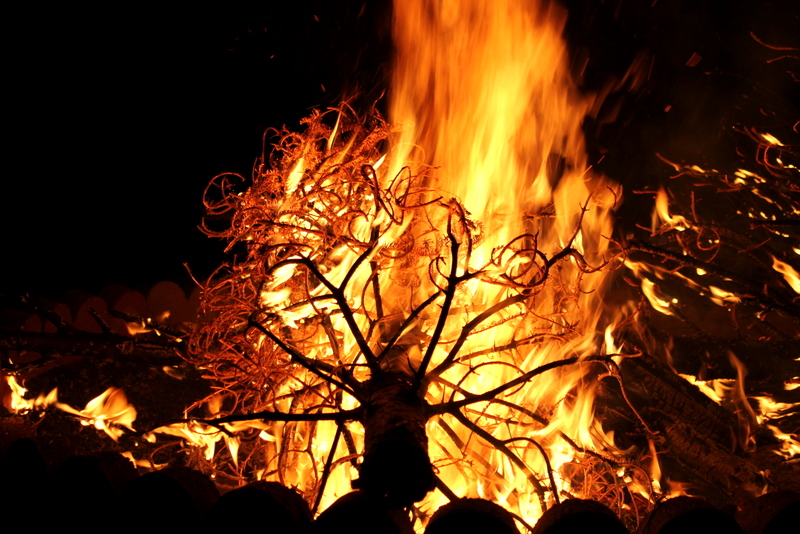

sage advice — it’s important we all keep on top of disease.
Man – Can you believe someone setting fire to their Bonsai. I came out in a cold sweat just reading it!
I remember at your workshop back in October you advised the use of Rose Clear Ultra as mentioned above. You also mentioned a copper sulphate solution for spraying my Olive tree (Can’t remember the name) both of which I bought from a local nursery the following day. I made notes of as much of the advice you gave to all of us as I could remember and marked my calendar with relevant dates for treatments etc.
We are as one as far as all things internet are concerned, you echo the thoughts of many I think.
I know you need to have a rant and rave every now and then, but believe me Graham, there are many, many people out there who rely on your guidance and expertise. The amazing range of trees and yamadori, blogs and videos make Kaizen Bonsai the best source for anybody who likes to play with trees.
So as far as I am concerned, you and the team are only ever a couple of clicks away (or a phone call if you like).
I’ll put my soapbox away now and get back to work.
Good article, although I wish someone would put out some information on needle cast on pines as all effective treatments appear to banned in the uk.
look first study and fix. relax watch your plants learn. if it doesn’t survive throw away
don’t burn as this will sent spores into the air to infect other plants in the area.
Thank you for setting all this knowledge out so clearly.The bit about the red mushroom might be quite useful down here only a few miles from Glastonbury.
I suffer Bonsai envy when I see your trees so I guess you have progressed. Love & Peace and happy Bonsai.